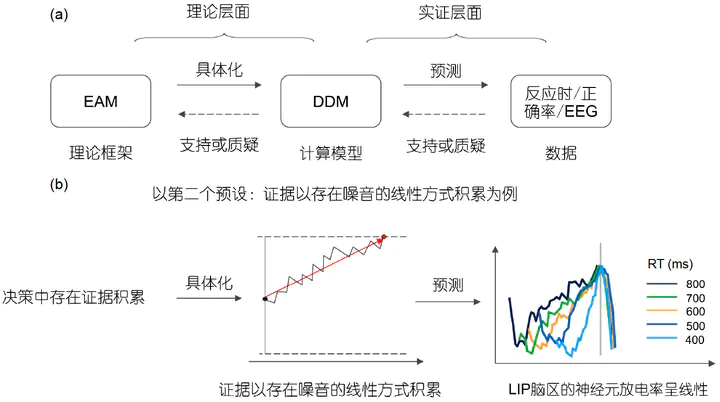Behavioral and cognitive neuroscience findings regarding assumptions of the evidence accumulation model

Abstract
The evidence accumulation model is a widely used cognitive model of human decision-making, which assumes that decision-makers continuously gather and integrate information into evidence relevant to the decision and make a decision once the accumulated evidence reaches a predefined threshold. With the increasing popularity of evidence accumulation model, some researchers claim it has reached a theoretical plateau and can be considered as the standard model for analyzing response time and choices. However, the theoretical assumptions underlying these models lack rigorous testing. As an example, the drift-diffusion model (DDM) is an instantiation of evidence accumulation and has five underlying assumptions (1) The universality of evidence accumulation; (2) the selectivity of evidence accumulation; (3) linear integration of evidence with noise; (4) a constant decision criterion; and (5) decision-making is independent of motor execution. DDM has been widely used in cognitive tasks, such as value-based decision-making, and social decision-making, probably due to the availability of user-friendly software for parameter estimation. However, only a few studies systematically examined to what extent these five assumptions of DDM were supported by empirical studies. To fill the gap, we reviewed studies that tested these five assumptions.For the first assumption of DDM, the universality of evidence accumulation, we only found direct evidence from studies that employed perceptual decision-making tasks. For other studies that used DDM for modeling, such as value-based decision-making or social decision-making, we found few studies that directly tested the existence of evidence accumulation. The second assumption, the selectivity of evidence accumulation, suggested that only information related to the goal would contribute to evidence accumulation. We did not find empirical data supporting this assumption except for O’Connell et al. However, evidence from conflict tasks (e.g., flanker task) suggested that information irrelevant to the goal may also be incorporated into the evidence accumulation. Data from conflict tasks inspired new models under evidence accumulation model and called for further investigation into the mechanism related to the selectivity of evidence. The third and fourth assumptions constitute the core assumptions of DDM, i.e., “evidence accumulate-to-bound”. Regarding the third assumption, which posits that evidence with noise is accumulated linearly, supporting data were found from animal studies and human EEG studies that employed perceptual decision-making. However, human EEG data from value-based decision-making tasks has challenged the validity of this assumption. The fourth assumption, that the decision criterion is constant, is controversial and has been challenged by several other evidence accumulation models, such as collapsing boundary models. The last assumption, that decision-making is independent of motor execution, has also been questioned by empirical data from both animal studies and human behavioral and electromyography data, despite support from EEG recording. In summary, we found that, while the standard DDM is commonly used in many sub-fields of psychology and neuroscience, empirical studies that directly tested five assumptions of DDM were mainly from perceptual decision-making tasks. Also, we found that challenging these assumptions often resulted in new computational models. These findings call for studies to test these assumptions and develop new models. Besides these findings suggest that researchers should be cautious when interpreting the parameters estimated from standard DDM. Finally, our review suggests that increasing transparency in model assumptions will accelerate the revision of models and theories, and ultimately deepen our understanding of human cognitive processes.